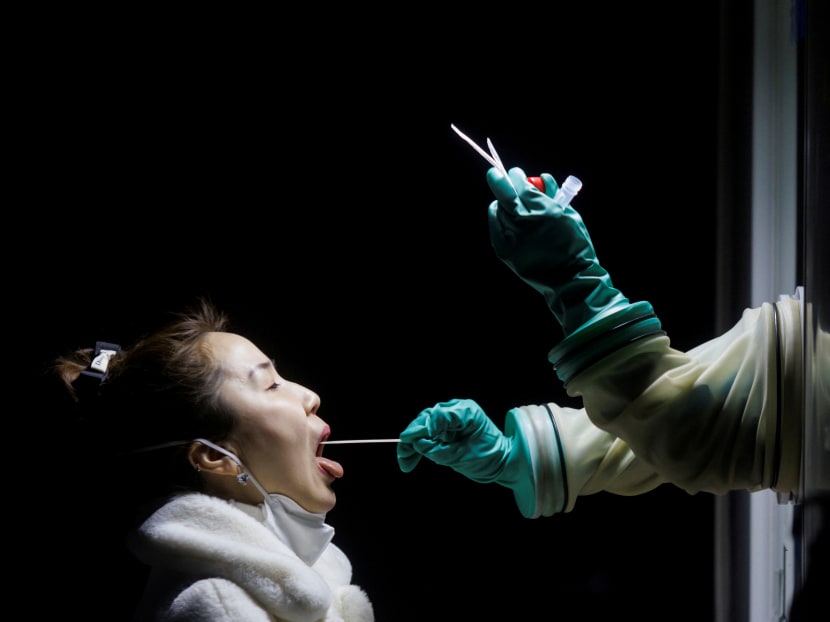Explainer: Swabbing the throat — does it work better for ART kits?
SINGAPORE — In recent weeks, an unproven hack to boost the accuracy of antigen rapid test (ART) kits has been making the rounds on social media, recommending that people swab their throats instead of their nostrils.

A woman receives a throat swab test at a street booth as the coronavirus disease (COVID-19) pandemic continues in Beijing, China, on Jan 17, 2022.
- A hack to increase the sensitivity of ART kits is making the rounds on social media, calling on people to swab the throat instead of the nose
- Such a method is not recommended by manufacturers of existing test kits
- It could work in theory, as the Omicron variant reproduces quickly in the throat
- Some jurisdictions have recommended combining swabbing both the throat and nose for the best results
- But in practice, a throat swab done at home by an untrained person can pose risks
SINGAPORE — In recent weeks, an unproven hack to boost the accuracy of antigen rapid test (ART) kits has been making the rounds on social media, recommending that people swab their throats instead of their nostrils.
The practice is growing in popularity globally on platforms such as TikTok, with videos of Covid-19-positive users testing themselves with nose swabs and getting a negative result, but then repeating the experiment again with throat swabs and testing positive with the coronavirus.
The hack has spread to Singapore, too: TikTok user Skingapore, who claims to be a certified general practitioner (GP) in Singapore and also goes by the name GP Samuel, showed how an ART with a throat swab was able to detect the disease, while a nose swab could not.
To find out, TODAY looked into what science and health experts say about this practice, which is currently not recommended by any ART kit manufacturers.
WHAT IS THE HACK?
A throat swab — also known as an oropharyngeal swab — involves swabbing a sample from the middle part of the throat, right behind the oral cavity.
Self-test kits here recommend doing nasal swabs instead, in which the swab enters around 2cm into the nostril.
This is different from nasopharyngeal swabs, such as those performed when collecting samples for polymerase chain reaction tests, which involve collecting a sample from the nasopharynx — the upper part of the throat behind the nose.
Another swabbing method is oral or saliva swabbing, which involves swabbing saliva around the mouth area. A variation of this is to test a sample of sputum, or phlegm, that is typically produced when a sick person coughs.
The hack calls for swabbing the oropharyngeal area, though other versions of the hack that only call for oral swabbing of the mouth region are also floating around on social media and messaging groups.
SO, DOES IT WORK?
In theory, yes, it works.
Before Omicron became dominant, researchers tested the effectiveness of different sampling methods using ART kits and found that nasopharyngeal swabs provided the greatest sensitivity.
In March last year, for example, researchers in Canada studying the use of the Abbott Panbio test kit with various swabbing methods quickly terminated the throat and saliva sample collection due to poor sensitivity compared to nasopharyngeal swabs.
But now, mounting evidence is showing that the Omicron variant of Sars-CoV-2, the virus which causes Covid-19, reproduces faster in the throat than in the lungs.
Dr Leong Hoe Nam, an infectious diseases expert at Rophi Clinic, explained that manufacturers did not recommend throat swab before the Omicron variant emerged because there was no advantage gained in test kit accuracy from doing so to test for earlier variants.
“The virus adapted and it is now a useful hack. The issue is whether (the science behind it) is validated,” he said.
In general, the virus is found best at the back of the nose (the nasopharynx) or the back of the throat (the oropharynx), said Dr Leong.
“The problem with the antigen testing of the nose is that the front of the nose doesn't have the most virus. But yet inserting it all the way to the back of the nose is not recommended for untrained individuals.”
“It is also uncomfortable for most people (to swab the back of the nose) with the swab provided,” he said.
This is why a throat swab with ART kits could work, Dr Leong said.
“In theory, it should be fine, but like all things in medicine, if it is not proven, we cannot endorse it,” he said.
WHAT’S THE CATCH?
In practice, however, there are also plenty of reasons why test kit manufacturers do not recommend throat swabs.
Such a hack would be considered as an “off label” use, said Dr Leong.
For one thing, the risk of a contaminated sample could cause false results, and it is generally easier to contaminate a throat swab after eating or drinking, or even by gagging.
Some TikTok users demonstrated that it is possible to create false positives with their test kits using acidic compounds, such as lemon juice.
Another compelling reason to avoid throat swabs is that it could be dangerous in a self-testing scenario, especially for people unfamiliar with swabbing. Current swabs provided with test kits are meant only for nasal use.
Acting commissioner for the US Food and Drug Administration (FDA) Janet Woodcock told a Senate committee on Jan 11: “People should not use swabs that are designed as nasal swabs and try to swab their throat… They may stab themselves.”
The FDA does not recommend swabbing the throat when performing a self-test with ART kits.
WHY NOT SWAB BOTH?
Elsewhere, the United Kingdom’s National Health Service also does not recommend swabbing the throat, but encourages people to swab both the nose and the throat, starting with the throat first. The Israeli Health Ministry also advised the same last month.
Doing so would give Covid-19 ART kits the greatest sensitivity, scientists have found.
Canadian researchers who studied at-home antigen kits last month found that swabbing both nostrils has a sensitivity of 68.4 per cent, combining both nasal and throat swabs has a sensitivity of 81.6 per cent, according to a preprint study which has not been peer-reviewed.
“Given the propensity of cold-like symptoms and complaints of sore throat during this period of high prevalence of Omicron, there was likely some validity to the media accounts of false-negative nares swabs, with subsequent follow-up positive throat swabs,” said the researchers from Dalhousie University in Nova Scotia, Canada.
Nevertheless, researchers recognised several limitations of their study, too, which was meant to compare the sensitivity of different swabbing approaches in a lab setting.
For instance, it is unclear how requiring swabs of both nose and throat would affect participation rates — people may end up testing less as a result.
Further studies are also warranted for other brands of test kits, since the Canadian researchers only looked at the Abbott Panbio kit in their study, which is also available in Singapore.
So, while it appears that this social media hack could very well turn out to be true, more work needs to be done to confirm which sampling method, whether it is nasal, throat, oral or saliva, is ideal in the real world.
Said Dr Leong: “Every company must do their own testing and show it works.”











